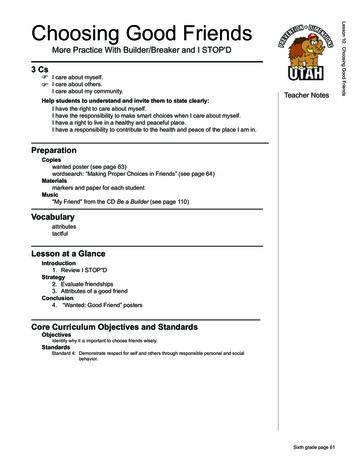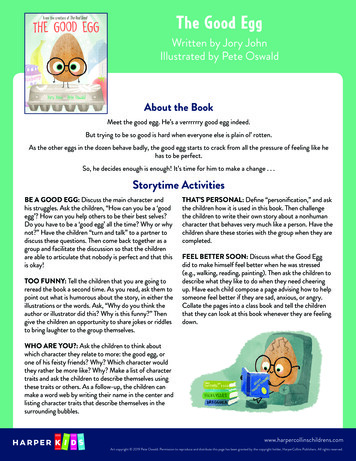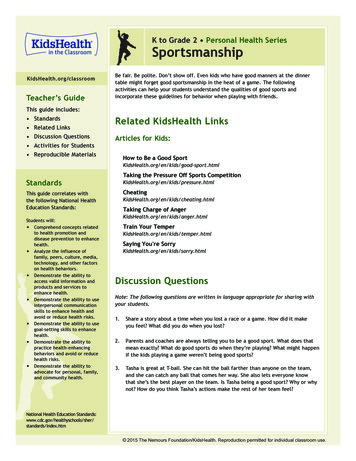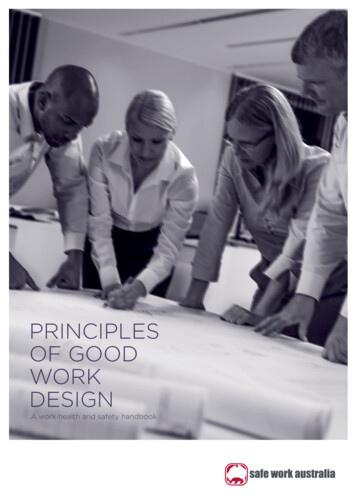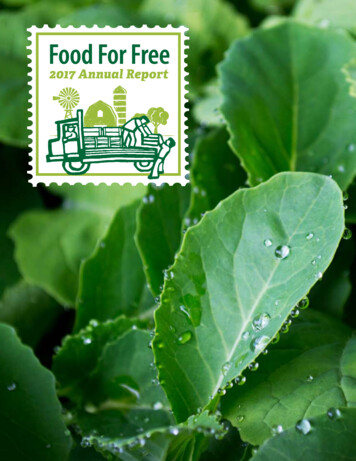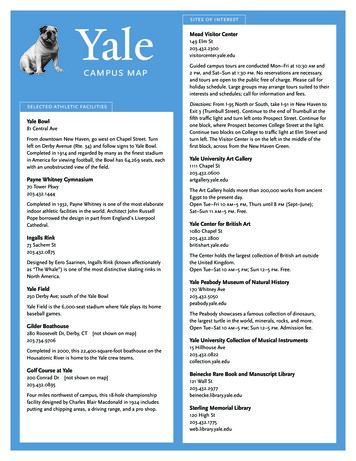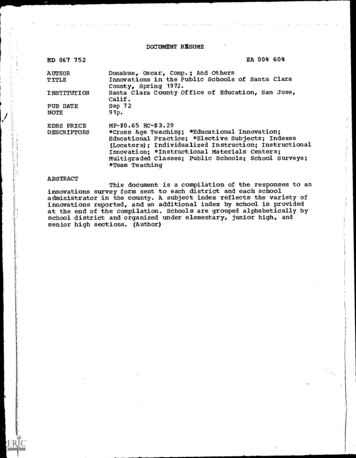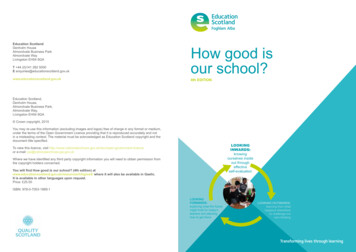
Transcription
Education ScotlandDenholm HouseAlmondvale Business ParkAlmondvale WayLivingston EH54 6GAT 44 (0)141 282 5000E tland.gov.ukHow good isour school?4th EDITIONEducation Scotland,Denholm House,Almondvale Business Park,Almondvale Way,Livingston EH54 6GA Crown copyright, 2015You may re-use this information (excluding images and logos) free of charge in any format or medium,under the terms of the Open Government Licence providing that it is reproduced accurately and notin a misleading context. The material must be acknowledged as Education Scotland copyright and thedocument title specified.LOOKINGINWARDS:knowingourselves insideout througheffectiveself-evaluationTo view this licence, visit ment-licenceor e-mail: psi@nationalarchives.gsi.gov.ukWhere we have identified any third party copyright information you will need to obtain permission fromthe copyright holders concerned.You will find How good is our school? (4th edition) atwww.educationscotland.gov.uk/resources/h/hgios4/ where it will also be available in Gaelic.It is available in other languages upon request.Price: 25.00ISBN: 978-0-7053-1889-1LOOKINGFORWARDS:exploring what the futuremight hold for today’slearners and planninghow to get thereLOOKING OUTWARDS:learning from whathappens elsewhereto challenge ourown thinking
ContentsForeword 03Introduction 05The Framework 14The Quality Indicators 15Leadership and Management 19Learning Provision 31Successes and Achievements 47Appendices 551
How good is our school?How good is our school?Chief Executive Officer’sForewordI am delighted to be able to introduce this new, updatedversion of How good is our school?, now in its fourth edition.Since first appearing on the Scottish education scene, Howgood is our school? has transformed our approaches toself-evaluation and improvement. This new edition is the resultof a wide-ranging consultation through which stakeholdershave contributed to the development of a substantially new setof quality indicators and supporting toolkit.How good is our school? is designed to promote effective self-evaluation as the firstimportant stage in a process of achieving self-improvement. The introduction andthe quality indicators are designed to reflect the rapidly developing context withinwhich schools now operate. This new publication is focused explicitly on making astrong contribution to our national imperative to continue to improve attainment forall, whilst also making a decisive shift towards closing the gap in attainment andachievement between the most disadvantaged children and their peers. This meansa strengthened focus on equality, wellbeing and skills for learning, life and work, allof which help ensure young people can secure the best possible post-schooldestination, and are well-equipped for a future characterised by continued lifelonglearning. These are key aspects of Curriculum for Excellence and they are strongthreads running throughout the new quality indicator framework.The toolkit of illustrations, exemplar features of highly-effective practice andchallenge questions are intended to be used by all types of practitioners at alllevels, and with a wide variety of different roles and responsibilities. They can beadapted and used with learners, parents and partners across the school communityto support collaborative enquiry and interrogative approaches to self-evaluation sothat schools are able to identify their own features of effective practice, and developa shared understanding of what to do next.To support such collaborative approaches further, Education Scotland is alsodeveloping a new National Improvement Hub. This will bring together our extensiverange of self-evaluation frameworks and improvement tools, including How good isour school? into one coherent and integrated digital resource – an educationimprovers’ portal, if you like, which will make the best use of digital technology topromote nationwide collaboration and exchange of knowledge and expertise acrossthe system. By bringing together these resources and networking opportunities, weaim to strengthen partnership working and evidence-based, system-wideimprovement at all levels.The publication of this edition of How good is our school? will be followed up with aprogramme of professional learning and support which all practitioners will be ableto access. Please take up these opportunities. I am confident that, used well, thisrevised edition of How good is our school? can help you and your colleaguesdeliver new levels of excellence and equity for the people this is all ultimately about– Scotland’s young learners.Bill Maxwell23
How good is our school?How good is our school?IntroductionThis edition of How good is our school? aims to support the growth of a cultureof self-improvement across Scottish education. It builds on previous editionsand continues the journey of moving Scottish education from being goodoverall to being great overall.“Evidence on the current performance of Scotland’s education system suggests thatwe have a good education system, which is performing strongly in a number ofrespects. However, we are not yet at the level of achieving consistently excellentlevels of performance which would match the world-leading ambition of our vision.”Education Scotland Corporate Plan 2013-2016 (p.15).Achieving this vision requires a sustained focus on improving educational outcomesfor all children and young people and particularly for those who experience highlevels of social, emotional and economic deprivation. We know that physical, social,emotional and economic wellbeing have a significant impact on children and youngpeople’s success in school and beyond school. We also know that aspects of thesefactors are significant barriers to learning and achievement for a large proportion ofour learners. Closing the gap in attainment, achievement and wellbeing betweenchildren and young people living in our most and least deprived areas is the keychallenge for Scottish education. It is a challenge that requires strong collaborativeapproaches within schools, between schools and with colleges, universities,employers and other partners locally and nationally.We know that physical, social, emotional andeconomic wellbeing have a significant impacton children and young people’s success inschool and beyond school. We also know thataspects of these factors are significantbarriers to learning and achievement for alarge proportion of our learners.Curriculum for Excellence clearly articulates our aspiration to be a nation ofsuccessful learners, responsible citizens, effective contributors and confidentindividuals so that everyone contributes to the sustainable economic growth of ourcountry. Achieving this requires highly effective leadership at all levels which isgrounded in the values of compassion, wisdom, justice and integrity.45
How good is our school?How good is our school?As a framework that underpins effective self-evaluation, How good is ourschool? (4th edition) will support practitioners and school leaders at alllevels to:z ensure educational outcomes for all learners are improving;z address the impact of inequity on wellbeing, learning and achievement;z consistently deliver high-quality learning experiences;z embed progression in skills for learning, life and work from 3-18;z further strengthen school leadership at all levels;z improve the quality and impact of career-long professional learning;A passionate commitment to ensuring social justice, children’s rights, learning forsustainability and equality are important prerequisites for all who deliver Scottisheducation. The themes of leadership, partnership, shared values, wellbeing, socialjustice and equality are returned to in different ways throughout this edition of Howgood is our school?. They are the foundation stones of an excellent school and, assuch, need to be firmly embedded within self-evaluation.ContextSince the publication of How good is our school? (3rd edition) in 2007, theaspiration for all schools to be ambitious, excellent schools has continued to bedriven forward through Curriculum for Excellence and other policy initiativesincluding Getting it right for every child (GIRFEC) and Teaching Scotland’s Future.Partnership working between key organisations supporting Scottish education hasstrengthened and we are well-placed to strengthen partnerships further at schooland community level, with a continued focus on collaboration to achieve improvedoutcomes for children, young people and families. The most recent Programme forthe Scottish Government has identified some significant priorities for the next stageof our improvement journey including the development of a new NationalImprovement Framework for Scottish Education along with Developing Scotland’sYoung Workforce and the Scottish Attainment Challenge. This edition of How goodis our school? aims to support your improvement within this significant agendathrough a continued focus on learning and learner outcomes.6z extend and deepen partnerships to improve outcomes for all learners;z increase learning for sustainability; andz tackle unnecessary bureaucracy.Partnership, collaboration and self-improvementMeeting the wide-ranging needs of all children, young people and their families isthe heart of what makes an excellent school. Schools cannot achieve this bythemselves. As noted in the Building the Curriculum series, strong, effectivepartnerships at local and national level are the key to future improvement in Scottisheducation. This edition of How good is our school? supports you to evaluate theimpact of your partnership-working and collaborative activity. You will have a rangeof partners such as the third sector, youth workers, community learning anddevelopment staff, colleges, universities and employers who work with you todeliver learning pathways to meet the needs of all children and young people. Otherpartners with specialist expertise in additional support needs will also workalongside you to remove barriers to learning and ensure all children and youngpeople experience success in school and beyond school.This new self-evaluation framework highlightspartnership and collaboration as significantfeatures of a highly-effective school and ahigh-performing learning system.7
How good is our school?How good is our school?The virtuous cycle of improvementThe virtuous cycle of improvement (see Figure 1 below) illustrates the key featuresof evidence-based self-improvement at school and at system-wide levels. It showshow school and system leaders can empower practitioners to interpret nationallyshared aims, such as the principles of Curriculum for Excellence, and apply them intheir local contexts in ways which are most appropriate to them. This virtuous cycleis relevant to all sectors of education. Working with the virtuous cycle will help youto understand the importance of regular and rigorous evidence-based internal andexternal evaluation to inform further improvement.Fig. 1: The virtuous cycle of improvementHow good is our school? is a toolkit for schools to use to engage in evidence-basedanalysis of what is working well and what needs to improve and have greaterpositive impact on learners. Use of the framework by staff in differing roles acrossyour school and with partners including colleges, universities, employers, localauthorities and Education Scotland will further strengthen your evaluative work.Excellent schools have robust internal approaches to self-evaluation and also valuethe objectivity which external partners can bring. Excellent schools understand thatself-evaluation should be an ongoing process. They continually reflect and evaluatetheir work and use the evidence from these activities to plan future improvement.Thus, the direction for future improvement comes from the school and its partners.This is the definition of self-improvement.Self-evaluation: looking inwardsared aims anlly shdganoaoitlsNaThe significant relationship between effective self-evaluation and schoolimprovement can also be seen as an “inwards, outwards, forwards” approach tohelp you and your partners answer the questions which remain at the heart ofself-evaluation:applied anddevelopedflexibility inlocal contextsz How are we doing?z How do we know?z What are we going to do now?knowledgespreadeffectively topractitionersimpactevaluated atmultiple levelsBETTERLEARNINGThrough this approach, you will look inwards to analyse your work, look outwards tofind out more about what is working well for others locally and nationally and lookforwards to gauge what continuous improvement might look like in the longer term.How good is our school? is intended to support you and your partners in lookinginwards to evaluate performance at every level and in using the informationgathered to decide on what needs to be done to improve.Fig. 2: Inwards, outwards, forwardscip les,experi e ncesesmreincoCoprknowledgedrawn outabout “whatworks”andexpectedoutLOOKING INWARDS:knowing ourselvesinside out througheffective self-evaluationLOOKING OUTWARDS:learning from whathappens elsewhere tochallenge our own thinkingexternal research and intelligenceLOOKINGFORWARDS:exploring whatthe future mighthold for today’slearners andplanning how toget there89
How good is our school?How good is our school?Triangulation of evidenceAs stage partners, departments orfaculties we critically analyse ourevidence and agree priorities forimprovement and how we will take theseforward together.We will use our self-evaluation tostrengthen partnership-workingwithin and beyond our localauthority through identification ofgood practice and a sharedunderstanding of what needsfurther improvement.As a learning community or cluster ofschools we will use our self-evaluation toidentify good practice and support eachother to be the best we can be. We willwork together to evaluate how our workimpacts on our learners and their families.SAs school leaders we willensure a culture of ongoingself-evaluation, evaluate evidencefrom across the whole schooland use this to plan changeand further improve.ATAEDITATIVEVALUATIONOF QUALITYIEWAs a class teacher I will use theframework to evaluate my workusing robust evidence to supportreflection and set my professionaldevelopment targets.V’SOngoing reflection, interrogation of evidence and working with othersare key to successful self-evaluation and self-improvementLEFig. 3: Collaborative approaches to self-evaluationOPEffective, ongoing self-evaluation provides a unique and valuable picture of what ishaving most and least impact on learners in a single class, at a stage, within aschool or across a cluster or local authority. It should take place within anaspirational vision for continuous school improvement where all stakeholdersconsider, “How good can we be?” Once the quality of the impact on learners hasbeen evaluated, then plans for improvement can be drawn up. Looking outwards, inother words learning from what happens elsewhere, and looking forwards, in otherwords exploring what the future might hold for today’s learners, can support theimprovement planning process. Looking outwards and forwards can provide thejustification for moving things in a different direction, and the motivation andinspiration that underpin a school’s vision to be the best it can be.Staff, pupils, parents/carers, partnersand other stakeholders such as thelocal authority or governing bodyshould all have regular opportunitiesto share their views about theschool. Examples of howpeople’s views can begathered include throughsurveys, focus groups,ongoing professionaldialogue, learningvisits and minutesof team meetings.PEThe collaborative action research approaches which featured in the SchoolImprovement Partnership Programme ogramme/intro.asp) are a key means of increasing innovation and continuous improvement acrossclassroom, school and local authority boundaries. Such approaches go beyondsimply sharing good practice. Collaborative enquiry brings depth to practitioners’professional learning and leads to more accurate and honest self-evaluation.Fig. 4: TriangulationSchools collect a wide range ofquantitative data for exampleabout attainment, attendance,bullying and prejudice-baseddiscrimination and optionchoices. Effective selfevaluation includesrigorous interrogationof this data by staffwho are data-literateand use the data torecognise emergingissues and whenspecific interventionsare necessary.ANTEffective self-evaluation involves a level of reflection and critical enquiry which isbest achieved through a blend of internal and external analysis. Making soundjudgements about the impact on learners should be central to self-evaluation.How good is our school? provides national guidance which your school and yourpartners can use when working together to evaluate your collective impact onimproving outcomes for the learners in your local community.Triangulation is the process used to ensure evaluative statements about strengthsand aspects for development are grounded in a robust evidence base. Thetriangulation of evidence-based information and data, people’s views and directobservation of practice should involve all school staff, learners, partners and otherstakeholders. This process leads to a shared assessment of risk and anunderstanding of your school’s capacity for continuous improvement.QUMaking sound judgements about theimpact on learners should be centralto self-evaluation.DIRECT OBSERVATIONDirect observations of practice can take place in a rangeof learning contexts including during learning which takesplace outdoors, in a workplace, at college and duringexcursions and residential experiences. Observations shouldbe linked to agreed criteria and a shared understanding oftheir purpose. All stakeholders including staff, learners,parents and partners can engage in these structuredobservations and give feedback to support self-evaluation.Looking inwards through engaging with specific self-evaluation questionsThe quality indicator framework is for use by all school staff regardless of their role.Other stakeholders should also see quality indicators and themes which relate totheir role in the school and can use the framework to support evaluations of theirwork. The framework emphasises and supports collaborative self-evaluation withinschool, between schools and with the wider range of stakeholders who contribute tochildren and young people’s learning and development. Children and youngpeople’s active participation in self-evaluation is an important factor. It is not alwaysnecessary to use a complete quality indicator or the entire framework for effectiveself-evaluation. However, over a three- to five-year period, it would be useful for youto demonstrate self-evaluation using all of the quality indicators. In this way you willbuild a complete picture of your school’s work and its capacity for improvement overtime and ensure no important aspects are overlooked.Identification of strengths and aspects for improvement involves knowing the impactof our work on learners. Learners are at the heart of effective self-evaluation1011
How good is our school?How good is our school?Headteachers have overall responsibility for ensuring the school has a clearlycommunicated strategic plan for self-evaluation which is ongoing and evidence-based.However, all staff are responsible for ensuring active self-evaluation in partnershipwith all stakeholders is at the heart of school improvement. Self-evaluation shouldnot be seen as an “add-on” or involve lots of additional time and bureaucracy. Itshould focus on the key work of your school – learning and teaching. Evidencegathered should arise from your ongoing work. The most important thing is beingable to demonstrate impact in relation to improved outcomes for your learners. Toachieve this you must continuously track and monitor children and young people’ssuccesses and achievements and use your self-evaluation to identify where yourschool is performing well and where it could do better. Weaknesses in theseoutcomes are usually the result of weaknesses within the learning provision orleadership and management, and often in both. Where outcomes are either notimproving or are deteriorating, you need to take swift action.Some examples of how this might work in practice can be found in Appendix 1.The forthcoming National Improvement Hub aims to extend this approach bymaking it easier to access all our self-evaluation frameworks and to select what youneed depending on the particular project or strand of work you want to evaluate.To support your self-evaluation strategy, individuals and teams of staff and partnersacross the school community will find the toolkit helps them to analyse the impact oftheir work on learners. Quality indicators or themes from different quality indicatorscan be bundled together to enable a focus on a particular area of work such asfamily learning, employability skills or ensuring equity. Developing more specificself-evaluation questions and identifying relevant partners can create a focusedcontext for this type of self-evaluation. This approach can help you identify aspectsof school life which need a greater focus through individual professionaldevelopment or collegiate working. Similarly, partners can develop their ownbespoke self-evaluation toolkit by bringing together quality indicators or themesfrom different self-evaluation frameworks.Whatiseon we waestintuqtore?ploexthmes will supptheortroouIsQk?orrwWhichWhonidence for thise evseldif-eovrvapln?tiouacaFig. 5: Self-evaluation – taking a closer lookWho is leadingthis self-evaluationactivity?1213
How good is our school?How good is our school?The frameworkThe quality indicatorsThe framework consists of a set of 15 quality indicators (QIs) designed to help youanswer three questions linked to important aspects of the work and life of yourschool. The quality indicators are therefore divided into three categories:z Leadership and Management: How good is our leadership and approach toimprovement?z Learning Provision: How good is the quality of care and education we offer?z Successes and Achievements: How good are we at ensuring the bestpossible outcomes for all our learners?When the evidence from quality indicators related to each of these categories iscombined, it can create a unique and powerful story to answer the central keyquestion: What is our capacity for continuous improvement? Or, in other words,how good can we be?Fig. 6: How good are we now? How good can we be?LEADERSHIPAND MANAGEMENT:How good is ourleadership andapproach toimprovement?What is ourcapacity forcontinuousimprovement?SUCCESSES ANDACHIEVEMENTS:How good are we atensuring the bestpossible outcomesfor all our learners?LEARNINGPROVISION:How good is thequality of the careand education weoffer?There is a set of QIs within each of the three categories. These can support you totake a closer look at specific aspects of your work and can be applied at classroom,department, faculty, whole-school, cluster and local authority level.Fig. 7: The quality indicatorsWhat is our capacity for improvement?Leadership andmanagementHow good is ourleadership andapproach toimprovement?Learning provisionHow good is the qualityof the care andeducation we offer?Successes andachievementsHow good are we atensuring the bestpossible outcomes forall our learners?1.1 Self-evaluation forself-improvement2.1 Safeguarding andchild protection3.1 Ensuring wellbeing,equality and inclusion1.2 Leadership of learning2.2 Curriculum3.2 Raising attainmentand achievement1.3 Leadership of change2.3 Learning, teachingand assessment3.3 Increasing creativityand employability1.4 Leadership andmanagement of staff2.4 Personalised support1.5 Management ofresources to promoteequity2.5 Family learning2.6 Transitions2.7 PartnershipsThis diagram illustrates the strong relationship between each of the aspects and thecentral question about the school’s capacity for improvement. A range ofappropriate evidence of all three aspects is required to evaluate the school’s overallperformance. It is however possible to use a only a few of the quality indicators oreven a cluster of themes across quality indicators to support self-evaluation relatedto very specific aspects of a school’s life and work.1415
How good is our school?How good is our school?The themesLearning ProvisionEffective self-evaluation and “looking inwards” means taking a closer look at howwell specific aspects of the school are working. The themes within each of thequality indicators support these activities.Leadership and ManagementHow good is the quality of care and education we offer?Quality IndicatorThemes2.1 Safeguarding and childprotectionz Arrangements for safeguarding,including child protectionz Arrangements to ensure wellbeingHow good is our leadership and approach to improvement?Quality IndicatorThemes1.1 Self-evaluation forself-improvementz Collaborative approaches to selfevaluationz National guidance and legislation2.2 Curriculumz Development of the curriculumz Analysis and evaluation of intelligenceand dataz Ensuring impact on learners’successes and achievements1.2 Leadership of learningz Professional engagement andcollegiate workingz Learning pathwaysz Skills for learning, life and work2.3 Learning, teaching andassessment1.3 Leadership of changez Developing a shared vision, values andaims relevant to the school and itscommunityz Strategic planning for continuousimprovementz Governance framework2.4 Personalised supportz Removal of potential barriers tolearning2.5 Family learningz Management of resources andenvironment for learningz Engaging families in learningz Early intervention and preventionz Quality of family learning programmes2.6 Transitionsz Building and sustaining a professionalstaff teamz Management of finance for learningz Universal supportz Targeted supportz Arrangements to support learners andtheir familiesz Collaborative planning and deliveryz Continuity and progression in learningz Staff wellbeing and pastoral support1.5 Management of resourcesto promote equityz Quality of teachingz Planning, tracking and monitoringz Implementing improvement andchange1.4 Leadership and managementof staffz Learning and engagementz Effective use of assessmentz Impact of career-long professionallearningz Children and young people leadinglearningz Rationale and design2.7 Partnershipsz The development and promotion ofpartnershipsz Collaborative learning andimprovementz Impact on learners1617
How good is our school?Successes and AchievementsHow good are we at improving outcomes for all our learners?Quality IndicatorThemes3.1 Ensuring wellbeing, equalityand inclusionz Wellbeingz Fulfilment of statutory dutiesz Inclusion and equality3.2 Raising attainment andachievementz Attainment in literacy and numeracyz Attainment over timeSection 1Leadership andManagementHOW GOOD IS OUR LEADERSHIP AND APPROACH TO IMPROVEMENT?z Overall quality of learners’achievementz Equity for all learners3.3 Increasing creativity andemployabilityz Creativity skillsz Digital innovationz Digital literacyz Increasing employability skillsLevel 5 IllustrationsFor the purposes of national benchmarking, the six point scale (Appendix 3)remains an important aspect of How good is our school? For each quality indicatorin the framework there is an illustration of what an evaluation of “very good” mightlook like. These illustrations are intended to support professional dialogue andcritical reflection during ongoing self-evaluation. They are broad generic illustrationswhich should be able to be applied in any type of school.Exemplar features of highly-effective practiceThe features of highly-effective practice included alongside each quality indicatorare there to help you identify the sorts of evidence which support self-evaluation.They are specific examples of practice that we have found to be successful in someschools but they are not a definitive list of the sorts of practice which might evidenceeach particular quality indicator. Amongst the examples you will find some thatrelate more to a particular sector or to particular groups of staff and stakeholders.They might not apply to your context. As part of your ongoing self-evaluation, ratherthan try to replicate these features of highly-effective practice, you should gathersimilar examples from your own setting to indicate the strengths of your work.Challenge questionsAlongside each indicator there is also a starter set of “challenge questions” tosupport professional dialogue and point to aspects of practice which might requirefurther improvement. Again, some of them are sector specific and they should notbe regarded as the only questions that can be asked. They can be used byindividual practitioners, but will lead to more meaningful reflection when used bygroups of staff, partners and other stakeholders to support a shared understandingof the school’s strengths and next steps.181.1 Self-evaluation for self-improvement1.2 Leadership of learning1.3 Leadership of change1.4 Leadership and management of staff1.5 Management of resources to promote equity
How good is our school?How good is our school?1.1 SELF-EVALUATION FORSELF-IMPROVEMENTThemes:z Collaborative approaches to self-evaluationz Analysis and evaluation of intelligence and dataz Impact on learners’ successes andachievementsThis indicator defines rigorous self-evaluation asa responsibility of all stakeholders. It highlights theimportance of partnership approaches to selfevaluation and continuous improvement. Itemphasizes the need for strong leadership androbust analysis of a range of intelligence anddata as essential features of effective continuousself-improvement. A key factor in this indicator isdemonstrating the impact of sel
How good is our school? How good is our school? 8 9 The virtuous cycle of improvement The virtuous cycle of improvement (see Figure 1 below) illustrates the key features

